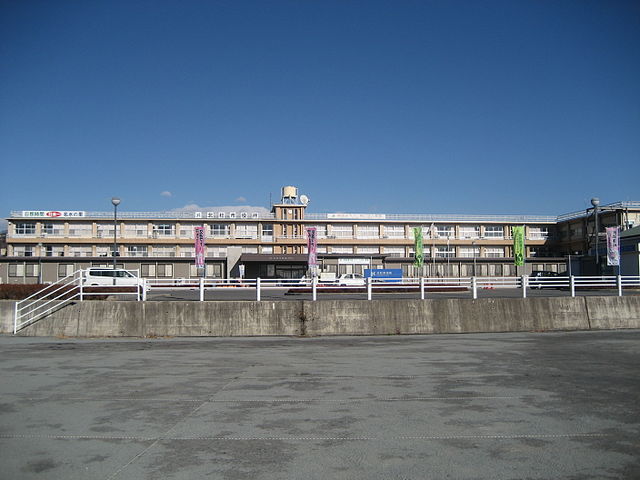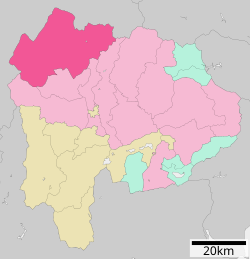Top Qs
Timeline
Chat
Perspective
Hokuto, Yamanashi
City in Chūbu, Japan From Wikipedia, the free encyclopedia
Remove ads
Hokuto (北杜市, Hokuto-shi) is a city located in Yamanashi Prefecture, Japan. As of 1 October 2020[update], the city had an estimated population of 45,684 in 22,091 households,[1] and a population density of 78 inhabitants per square kilometre (200/sq mi). The total area of the city is 602.48 square kilometres (232.62 sq mi).
Remove ads

Remove ads
Geography
Summarize
Perspective
Hokuto is located in far northwest Yamanashi Prefecture. Most of the area of the city is elevated highland and forested, with one third of the city located on the alpine southeastern slopes of Mount Yatsugatake, With a cooler alpine climate in summer, smaller towns such as Kiyosato are a popular location for second homes.
Neighboring municipalities
Climate
The city has a climate characterized by hot and humid summers, and relatively mild winters (Köppen climate classification Cfa). The average annual temperature in Hokuto is 11.2 °C. The average annual rainfall is 1296 mm with September as the wettest month. The temperatures are highest on average in August, at around 23.8 °C, and lowest in January, at around -1.0 °C.[2]
Remove ads
Demographics
Per Japanese census data,[5] the population of Hokuto has remained relatively stable over the past 50 years.
History
During the Edo period, all of Kai Province was tenryō territory under direct control of the Tokugawa shogunate. During the cadastral reform of the early Meiji period on April 1, 1889, the rural district of Kitakoma was formed.
The modern city of Hokuto was established on November 1, 2004, from the merger of the towns of Hakushū, Nagasaka, Sutama and Takane, and the villages of Akeno, Mukawa and Ōizumi (all from Kitakoma District).[6][7] On March 15, 2006, Hokuto absorbed the town of Kobuchisawa (also from Kitakoma District). Kitakoma District was dissolved as a result of this merger.
Government
Hokuto has a mayor-council form of government with a directly elected mayor and a unicameral city legislature of 22 members.
Economy
The economy of Hokuto is primarily agricultural, with seasonal tourism, precision manufacturing and food processing playing secondary roles.
Education
- Teikyo-Gakuen Junior College
- Hokuto has eight public elementary schools and nine public middle schools operated by the city government and two public high schools operated by the Yamanashi Prefectural Board of Education.
Transportation
Railway
Highway
Sister cities
 Fukuroi, Shizuoka, since March 9, 1987 between former Asaba, Shizuoka and former Akeno, Yamanashi
Fukuroi, Shizuoka, since March 9, 1987 between former Asaba, Shizuoka and former Akeno, Yamanashi Joetsu, Niigata, since January 17, 1991 between former Misaka Town and former Kakizaki, Niigata and Sutama, Yamanashi
Joetsu, Niigata, since January 17, 1991 between former Misaka Town and former Kakizaki, Niigata and Sutama, Yamanashi Hamura, Tokyo, since October 1, 1996 with former Takane Town
Hamura, Tokyo, since October 1, 1996 with former Takane Town Nishitokyo, Tokyo, since February 4, 1999 between former Tanashi, Tokyo and the former town of Sutama, Yamanashi
Nishitokyo, Tokyo, since February 4, 1999 between former Tanashi, Tokyo and the former town of Sutama, Yamanashi Madison County, Kentucky, United States, since May 12, 1990 with former municipalities of Takane, Nagasaka, Ōizumi, and Kobuchisawa
Madison County, Kentucky, United States, since May 12, 1990 with former municipalities of Takane, Nagasaka, Ōizumi, and Kobuchisawa LeMars, Iowa, United States, since July 3, 1993 with former Sutama Town
LeMars, Iowa, United States, since July 3, 1993 with former Sutama Town Pocheon, Gyeonggi-do, South Korea, since March 21, 2003 with former Takane Town[8]
Pocheon, Gyeonggi-do, South Korea, since March 21, 2003 with former Takane Town[8] Manciano, Tuscany, Italy with former Kobuchisawa Town
Manciano, Tuscany, Italy with former Kobuchisawa Town Crowsnest Pass, Alberta (unratified)
Crowsnest Pass, Alberta (unratified)
Remove ads
Local attractions
- Gikosan Yanodo Temple
- Kinsei ruins, a Jomon-period settlement trace and National Historic Site.
- Kitashōji Falls, one of Japan's Top 100 Waterfalls
- Kiyosato Plateau
- Musée Kiyoharu Shirakaba
- Nakamura Keith Haring Collection
- Seicho-no-Ie International Headquarters[9]
- Umenoki ruins, a Jomon-period settlement trace and National Historic Site.
- Yato Castle, ruins of a Sengoku period castle, and National Historic Site
References
External links
Wikiwand - on
Seamless Wikipedia browsing. On steroids.
Remove ads





